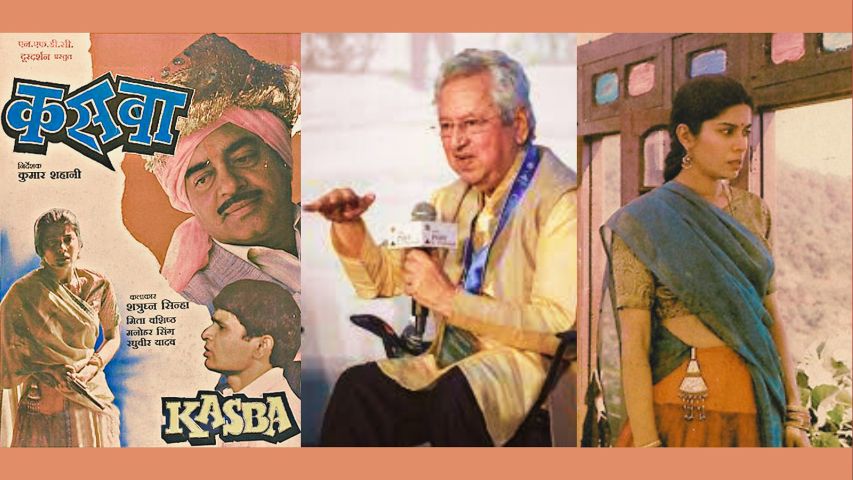-853X543.jpg)
A CHAPTER ON KUMAR SHAHANI’S KASBA
by O.P. Srivastava December 14 2023, 12:00 am Estimated Reading Time: 4 mins, 16 secsKumar Shahani’s aesthetic sensibilities were shaped while assisting Robert Bresson on Une Femme Douce (A Gentle Woman, 1969). Additionally, maverick filmmaker Ritwik Ghatak also mentored Shahani while he was at FTII, writes O.P. Srivastava
Kasba (The Town) is a 1991 Hindi film directed by Kumar Shahani. It is based on a short story, In the Ravine, by Russian author Anton Chekhov. Bhisham Sahni, Gulzar, Fareeda Mehta and Kumar Shahani wrote the script and dialogues. The cast of the film included Navjot Hansra, MK Raina, Manohar Singh, Shatrughan Sinha, Mita Vashisht and Raghubir Yadav. KK Mahajan did the cinematography and Vanraj Bhatia provided the background score. It is a 110-minute film produced by the NFDC. The film was shot in Palampur, in the Kangra Valley, a picturesque, peaceful place situated in the foothills of the snow-capped Himalayas.
Though largely influenced by Bresson and Italian filmmaker Roberto Rossellini, Shahani developed his own cinematic idiom called ‘formalism’, which he introduced in his first film Maya Darpan (1972).
‘There is austerity in Bresson. But there is a possibility in cinema to have both. In Bresson, there is mainly austerity even though he aspires to have spectacle. When I work along those lines, I want the ornamentation to stand out. The magic of that reality must appear and we ought to allow that to happen. The notion of ornamentation that we have in India, the alankar (ornamentation) of how we play with it, that is something I like to retain in my work’, Shahani said in an interview.
Formalism aims to create a new meaning by juxtaposing two concrete images and by divorcing sound and image while using the cinematic medium. According to Shahani, cinema can be created to generate a third meaning, the oblique meaning, through the juxtaposition of images. This approach aligned with the belief of Eisenstein, the Russian film director and film theorist, who pioneered the use of montages in films. Eisenstein believed that the work of art should be significant meaning thereby that the art must create new meanings. Shahani’s unconventional approach to filmmaking has elicited mixed reactions in India, though his films have been widely appreciated in various international film festivals. For example, Kasba (1990), his third film, was screened in eleven film festivals outside the country, including at Rotterdam, London, Brussels, Lisbon, Hong Kong and Edinburgh.

Kasba was one of the most slow-paced yet engaging films of the 1990s, when the parallel cinema wave was reaching its peak. The film deals with the growing tensions and fissures in our patriarchal feudal society and its detachment from the changing times. The changes in the film are represented through the advent of new industrial projects in the valley, which open up new financial avenues for the local residents. The moving undercurrents of time are manifested in the changing behaviour of the protagonist Tejo (Mita Vashisht), who runs her father-in-law’s family business in the absence of his sons and sees new economic opportunities in these projects. The family’s patriarch Maniram (Manohar Singh), clinging to the traditional belief that only a male descendent can inherit his wealth, finds it difficult to cope with the shift in power within the family, which is tilting in favour of a woman. This makes him feel left out and redundant.
The film blog Ellipsis wrote an interesting review for the film. It said, ‘One of the most impressive aesthetic elements of Kasba is the positioning of the camera, moving only to parallel the psychological and emotional mood of the characters, whilst windows and doorways are used repeatedly throughout to frame the actions of characters so that the exterior landscapes merge seamlessly with the interiors creating a feeling of social inertia and rural decadence’.
The visual integration of the house’s interiors with the valley’s landscape takes the viewers along the internal journey of the characters, especially Tejo, who is simultaneously inside and outside the house, thinking about household issues as well as what’s happening in the kasba (the town).
In terms of visual composition, Shahani relies a great deal on the master shot - much of the narrative action unfolds organically. The interior shots are dominated by miniature art of the Kangra Valley. Furthermore, the natural sounds of the valley are used extensively to evoke peace and tranquillity and accentuate the murmurs over the fight for the inheritance.
At times, Shahani’s emphasis on the rituals and traditions reminds one of his philosophical approach to life. Tejo’s hidden activities, the covert land deal and planning of her sister-in-law’s eviction, and the death of her child are left for the audience to infer. In many ways, the characters, except perhaps Tejo who looks imported from outside the valley, seem trapped in the past, paralyzed by tradition. A rather tranquilized backdrop of the remote valley amplifies their sense of inertia.
Released when parallel cinema was reaching the zenith of creativity and experimentation, Kasba is a significant milestone. Kumar Shahani’s adaptation of an Anton Chekhov novella is available on MUBI.




-173X130.jpg)
-173X130.jpg)
-173X130.jpg)
-173X130.jpg)
-173X130.jpg)
-173X130.jpg)
-173X130.jpg)
-173X130.jpg)